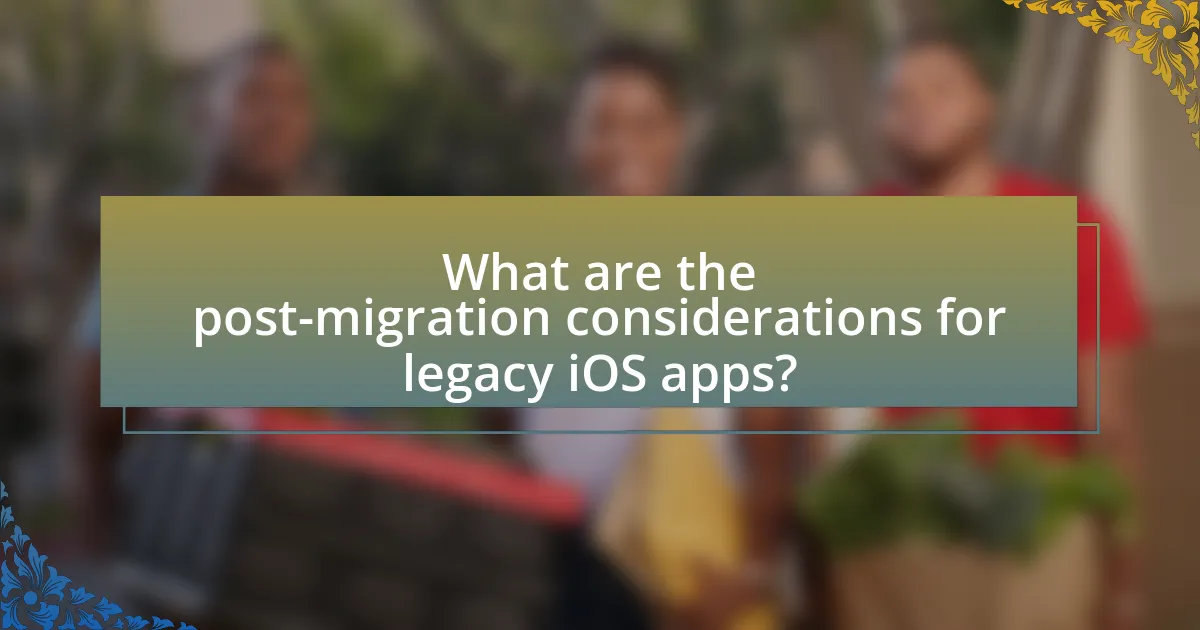Migrating legacy iOS apps to Swift involves a comprehensive process of rewriting Objective-C code, updating dependencies, and ensuring compatibility with modern iOS frameworks. This transition is driven by Swift’s advantages, including enhanced safety features, improved performance, and a more modern syntax that facilitates code maintainability. Key challenges during migration include compatibility issues, codebase complexity, and skill gaps among developers. Effective strategies for successful migration encompass thorough planning, incremental code conversion, and rigorous testing, while post-migration considerations focus on optimizing performance and incorporating user feedback. Overall, adopting Swift not only improves app stability and performance but also aligns with future development trends in the iOS ecosystem.

What does migrating legacy iOS apps to Swift involve?
Migrating legacy iOS apps to Swift involves rewriting existing Objective-C code in Swift, updating dependencies, and ensuring compatibility with the latest iOS frameworks. This process requires a thorough analysis of the current codebase to identify components that need modification or replacement. Additionally, developers must address potential issues related to memory management, type safety, and performance optimizations that Swift offers over Objective-C. The transition also includes testing the new Swift code to ensure functionality remains intact and that the app performs efficiently on current iOS versions.
Why is migration from Objective-C to Swift necessary?
Migration from Objective-C to Swift is necessary due to Swift’s modern syntax, enhanced safety features, and improved performance. Swift offers type safety, which reduces runtime crashes and enhances code reliability, making it easier for developers to write and maintain code. Additionally, Swift’s interoperability with Objective-C allows for gradual migration, enabling developers to leverage existing code while adopting new features. The adoption of Swift is also driven by its growing community support and frequent updates from Apple, which ensure that developers have access to the latest tools and best practices.
What are the limitations of legacy Objective-C code?
Legacy Objective-C code has several limitations that hinder modern development practices. Firstly, it lacks support for modern programming paradigms such as type safety and functional programming, which are integral to Swift. This absence can lead to increased runtime errors and less maintainable code. Additionally, legacy Objective-C does not support features like optionals, generics, and closures, which are essential for writing concise and safe code in contemporary applications. Furthermore, the syntax of Objective-C can be verbose and less intuitive compared to Swift, making it harder for new developers to adopt and understand. These limitations contribute to challenges in maintaining and updating legacy applications, as well as in integrating with newer frameworks and libraries that are designed with Swift in mind.
How does Swift improve app performance and maintainability?
Swift improves app performance and maintainability through its modern language features and efficient memory management. The use of type inference and optionals in Swift reduces the likelihood of runtime errors, leading to more stable applications. Additionally, Swift’s automatic reference counting (ARC) optimizes memory usage, which enhances performance by minimizing memory leaks and improving resource management. Swift’s concise syntax and powerful standard library facilitate easier code readability and maintenance, allowing developers to implement changes more efficiently. These features collectively contribute to faster development cycles and higher-quality applications.
What are the key challenges faced during migration?
The key challenges faced during migration of legacy iOS apps to Swift include compatibility issues, codebase complexity, and team skill gaps. Compatibility issues arise because existing Objective-C code may not seamlessly integrate with Swift, leading to potential runtime errors. Codebase complexity is a challenge as legacy apps often contain outdated architecture and dependencies that require significant refactoring. Additionally, team skill gaps can hinder the migration process, as developers may lack experience with Swift’s syntax and paradigms, impacting the overall efficiency and effectiveness of the migration. These challenges necessitate careful planning and execution to ensure a successful transition.
How do compatibility issues arise during migration?
Compatibility issues arise during migration when legacy iOS apps, originally developed in Objective-C, encounter differences in language syntax, frameworks, and APIs when transitioning to Swift. These issues stem from the fundamental differences in memory management, type safety, and error handling between the two languages. For instance, Objective-C uses manual reference counting, while Swift employs automatic reference counting, which can lead to memory leaks or crashes if not properly addressed during migration. Additionally, certain APIs may have been deprecated or replaced in Swift, requiring developers to find alternatives or rewrite portions of the code. This complexity is further compounded by the need to ensure that third-party libraries and frameworks used in the legacy app are compatible with Swift, which may necessitate updates or replacements.
What are the common pitfalls in the migration process?
Common pitfalls in the migration process of legacy iOS apps to Swift include inadequate planning, insufficient testing, and overlooking dependencies. Inadequate planning can lead to misalignment between project goals and technical requirements, resulting in delays and increased costs. Insufficient testing may cause critical bugs to go unnoticed, compromising app performance and user experience. Overlooking dependencies can create compatibility issues, as legacy code may rely on outdated libraries or frameworks that do not function well with Swift. These pitfalls can significantly hinder the migration process, as evidenced by case studies where teams faced extended timelines and budget overruns due to these challenges.
What strategies can be employed for a successful migration?
To achieve a successful migration of legacy iOS apps to Swift, employing a phased approach is essential. This strategy involves breaking down the migration process into manageable stages, allowing for incremental testing and validation. For instance, starting with the most critical components of the app ensures that core functionalities are preserved while transitioning to Swift. Additionally, utilizing automated testing tools can help identify issues early in the migration process, thereby reducing the risk of introducing bugs. Research indicates that organizations that adopt a phased migration strategy experience a 30% reduction in overall project time and a significant decrease in post-migration defects.
How can incremental migration be effectively implemented?
Incremental migration can be effectively implemented by adopting a phased approach that allows for gradual transition from legacy code to Swift. This involves identifying and isolating components of the legacy application that can be rewritten in Swift while maintaining interoperability with the existing Objective-C code.
To ensure a smooth transition, developers should utilize bridging headers to facilitate communication between Swift and Objective-C, allowing for seamless integration. Additionally, employing automated testing throughout the migration process helps to validate functionality and catch issues early.
Research indicates that incremental migration reduces risk and allows teams to adapt to changes progressively, as evidenced by case studies where companies successfully transitioned to Swift without significant downtime or loss of functionality.
What tools and resources are available to assist in migration?
Tools and resources available to assist in migration include Xcode’s migration assistant, Swiftify, and various online documentation and community forums. Xcode’s migration assistant automates the process of converting Objective-C code to Swift, significantly reducing manual effort. Swiftify is a third-party tool that provides a web-based service for converting Objective-C code to Swift, offering additional features like code optimization. Online documentation from Apple and community forums such as Stack Overflow provide valuable insights and troubleshooting tips, enhancing the migration process. These resources collectively streamline the transition from legacy iOS apps to Swift, ensuring a more efficient and effective migration.

How can developers prepare for migrating legacy iOS apps?
Developers can prepare for migrating legacy iOS apps by conducting a thorough code audit to identify dependencies, deprecated APIs, and areas requiring refactoring. This initial assessment allows developers to understand the current state of the app and plan necessary updates. Additionally, creating a comprehensive migration strategy that includes timelines, resource allocation, and testing protocols is essential. According to Apple’s documentation, leveraging Swift’s interoperability with Objective-C can facilitate a smoother transition, enabling developers to incrementally migrate components rather than rewriting the entire application at once. This approach minimizes risks and allows for continuous functionality during the migration process.
What steps should be taken before starting the migration process?
Before starting the migration process of legacy iOS apps to Swift, it is essential to conduct a thorough assessment of the existing codebase. This assessment should include identifying dependencies, evaluating the current architecture, and determining the scope of the migration. For instance, understanding the complexity of the existing Objective-C code and its integration with third-party libraries is crucial, as it informs the migration strategy and helps in estimating the time and resources required. Additionally, creating a backup of the current application ensures that there is a fallback option in case of issues during migration.
How can a code audit help in the migration preparation?
A code audit can significantly aid in migration preparation by identifying existing code issues and dependencies that may complicate the transition to Swift. This process involves a thorough examination of the legacy codebase to uncover bugs, outdated libraries, and architectural flaws that could hinder migration. For instance, a study by the IEEE on software maintenance highlights that 70% of software failures are due to poor code quality, emphasizing the importance of addressing these issues before migration. By resolving these problems during the audit, developers can ensure a smoother transition, reduce potential migration risks, and enhance the overall quality of the new Swift application.
What role does team training play in successful migration?
Team training plays a crucial role in successful migration by equipping developers with the necessary skills and knowledge to effectively transition legacy iOS apps to Swift. This training ensures that team members understand Swift’s syntax, features, and best practices, which are essential for maintaining code quality and performance during the migration process. Research indicates that organizations that invest in comprehensive training programs experience a 30% reduction in migration-related errors, leading to smoother transitions and faster project completion times. By fostering a collaborative learning environment, team training also enhances communication and problem-solving capabilities, further contributing to the overall success of the migration effort.
What best practices should be followed during migration?
During migration of legacy iOS apps to Swift, best practices include thorough planning, incremental migration, and comprehensive testing. Thorough planning involves assessing the existing codebase to identify dependencies and potential challenges, ensuring a clear roadmap for the migration process. Incremental migration allows developers to convert components gradually, reducing risk and enabling easier debugging. Comprehensive testing is essential to validate functionality and performance after each migration step, ensuring that the app maintains its integrity and user experience. These practices are supported by industry standards, which emphasize the importance of structured approaches in software migration to minimize disruptions and enhance code quality.
How can version control systems facilitate the migration process?
Version control systems facilitate the migration process by enabling developers to track changes, collaborate effectively, and manage different versions of code during the transition from legacy iOS apps to Swift. These systems allow for branching, which lets developers work on migration tasks independently without disrupting the main codebase. Additionally, version control systems provide a history of changes, making it easier to identify and revert problematic updates, thus ensuring a smoother migration. For instance, Git, a widely used version control system, supports features like pull requests and code reviews, which enhance collaboration and quality assurance during the migration process.
What testing strategies are essential during migration?
Essential testing strategies during migration include unit testing, integration testing, and regression testing. Unit testing ensures that individual components function correctly after migration, while integration testing verifies that these components work together seamlessly in the new environment. Regression testing is crucial to confirm that existing functionalities remain intact and unaffected by the migration process. These strategies collectively help identify issues early, reduce risks, and ensure a smooth transition to Swift, ultimately enhancing the app’s performance and reliability.

What are the post-migration considerations for legacy iOS apps?
Post-migration considerations for legacy iOS apps include ensuring compatibility with the latest iOS versions, optimizing performance, and updating user interfaces to align with current design guidelines. Compatibility is crucial as legacy apps may rely on deprecated APIs, which can lead to functionality issues in newer iOS environments. Performance optimization is necessary to leverage Swift’s efficiency, as legacy Objective-C code may not utilize modern Swift features effectively. Additionally, updating the user interface is important to enhance user experience and maintain relevance, as design standards evolve over time. These considerations are essential for maintaining app functionality, user satisfaction, and overall app longevity in a competitive market.
How can developers ensure the stability of the migrated app?
Developers can ensure the stability of the migrated app by implementing thorough testing protocols throughout the migration process. This includes unit testing, integration testing, and user acceptance testing to identify and resolve issues early. According to a study by the International Journal of Software Engineering and Its Applications, rigorous testing can reduce post-deployment defects by up to 40%. Additionally, utilizing automated testing tools can streamline the process and enhance coverage, ensuring that all functionalities are validated against expected outcomes. By continuously monitoring performance metrics post-migration, developers can quickly address any stability concerns that arise.
What monitoring tools can be used to track app performance post-migration?
To track app performance post-migration, tools such as New Relic, AppDynamics, and Firebase Performance Monitoring can be utilized. New Relic provides real-time analytics and performance monitoring, allowing developers to identify bottlenecks and optimize user experience. AppDynamics offers deep insights into application performance and user interactions, enabling teams to troubleshoot issues effectively. Firebase Performance Monitoring helps developers understand how their app performs from the user’s perspective, providing metrics on app startup time, network requests, and more. These tools are widely recognized in the industry for their effectiveness in monitoring application performance after migration.
How should user feedback be incorporated after migration?
User feedback should be incorporated after migration by systematically collecting, analyzing, and implementing suggestions from users to enhance the application. This process involves utilizing surveys, user interviews, and analytics tools to gather insights on user experience and functionality. For instance, a study by Nielsen Norman Group highlights that user feedback can lead to a 20-50% improvement in usability when effectively integrated into the development cycle. By prioritizing feedback, developers can address pain points and optimize the app’s performance, ensuring it meets user expectations and improves overall satisfaction.
What are the long-term benefits of migrating to Swift?
Migrating to Swift offers long-term benefits such as improved performance, enhanced safety, and increased developer productivity. Swift’s modern syntax and features, like optionals and type inference, reduce the likelihood of runtime crashes, leading to more stable applications. Additionally, Swift’s performance is optimized for speed, often outperforming Objective-C, which can result in faster app execution and better user experiences. The language’s growing popularity also means a larger pool of developers familiar with Swift, facilitating easier recruitment and collaboration. According to a Stack Overflow survey, Swift is one of the most loved programming languages, indicating strong community support and continuous improvement.
How does Swift adoption impact future app development?
Swift adoption significantly enhances future app development by providing a modern, efficient programming language that improves code safety and performance. The language’s strong typing and error handling features reduce runtime crashes, which is crucial for maintaining app reliability. Additionally, Swift’s interoperability with Objective-C allows developers to gradually migrate legacy iOS apps, facilitating a smoother transition without complete rewrites. According to a 2021 survey by Stack Overflow, Swift is among the most loved programming languages, indicating a strong developer preference that can lead to increased innovation and community support in future app development.
What are the implications for maintaining and updating the app in Swift?
Maintaining and updating an app in Swift involves considerations such as code compatibility, performance optimization, and adherence to evolving Swift language features. Swift’s strong typing and safety features require developers to regularly refactor code to ensure compatibility with new versions, which can lead to increased development time. Additionally, performance improvements in Swift necessitate ongoing updates to leverage enhancements, such as faster execution and reduced memory usage. The transition from Objective-C to Swift also implies that legacy code may need to be rewritten or bridged, which can complicate maintenance efforts. Regular updates are essential to address security vulnerabilities and to comply with the latest iOS guidelines, ensuring the app remains functional and competitive in the market.
What practical tips can help in the migration process?
To facilitate the migration process of legacy iOS apps to Swift, developers should adopt a phased approach, starting with a thorough assessment of the existing codebase. This assessment helps identify critical components and dependencies that require attention. Following this, developers should incrementally refactor the code, converting small modules or features to Swift one at a time, which minimizes risk and allows for easier debugging. Additionally, leveraging interoperability between Objective-C and Swift can ease the transition, as developers can call Swift code from Objective-C and vice versa, ensuring that the app remains functional throughout the migration. Utilizing automated tools for code conversion can also streamline the process, reducing manual effort and potential errors. These strategies are supported by industry practices that emphasize gradual migration to maintain app stability and performance during the transition.











